Yesterday we had decided to go on a guided tour of Tahiti’s undeveloped interior. We booked a tour of the interior of the island with Tahiti Safari Expedition. Our tour guide picked us up about 9:00 am at the marina that we are anchored near. There were supposed to be five more people on the tour with us, but none of them showed up, so it was just the two of us. We are getting used to having private tours and will be sad when the day comes that we have to share a tour with others.
The vehicle was a 4 wheel drive land rover with two benches in the back running the length of the truck bed. The truck looked like it was ready for combat — it even has a snorkel on it so it can be almost fully immersed under the water and keep going.

We drove from the marina through downtown Papeete. Eric thinks it looks like Miami, with the heavily trafficked streets, palm trees and other similar foliage, and the views of the ocean. What is interesting is that you can see the line of where the ocean ends and the lagoon begins, even though you cannot see the actual reef that creates the line.
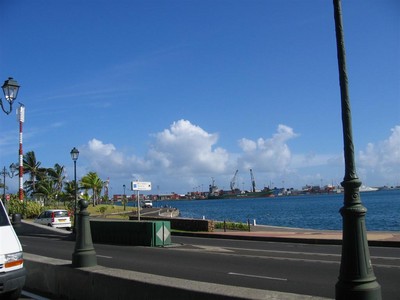
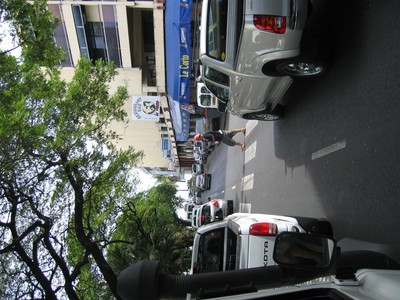
Beyond downtown the road went from four lanes down to two lanes. The father we went, the less commercial buildings and more residential buildings. Not too far beyond downtown we saw actual beaches with waves hitting the sand. There must be breaks in the reef here. Christi was surprised to see that the beaches are black sand, since for some reason you always associate Tahiti with white sand beaches. There were a large number of people out surfing. Tahiti is supposedly where surfing was invented.
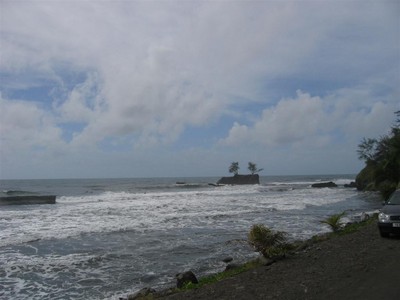
And here is a view of Papeete from the suburbs
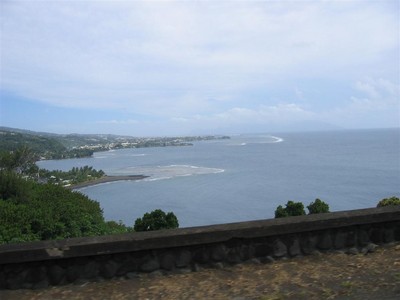
After what seemed like a long drive, we turned off the main road onto a dirt road. We were in a small suburban town called Papenoo. After only a few hundred feet, all the residences ended and it became vacant land all around us, very thick with vegetation. We were in a river valley called Papenoo Valley, surrounded by mountains. The river running through it is called the Vaituoru River. Shortly after turning off the main road, we made our first stop at a pretty waterfall. Our tour guide, Aaron, said it is believed that the natives threw criminals off this waterfall as punishment for crimes back in the pre-European days. The pool at the bottom is shallow and no one could survive the fall.
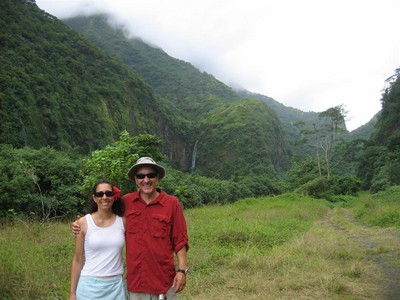
Aaron is a Frenchman who came to Tahiti while in the military and stayed. Aaron was full of information about the history, culture and politics of the region. It was nice having him to ourselves. We bombarded him with questions and he happily answered them all. While the tour itself was scenic, what made the tour worthwhile was all that we learned from Aaron.
One of the things Aaron talked about a lot was the non-native vegetation and animals. Tahiti, and for that matter all of the other islands, are completely different places today than they were 100 years ago. When Captain Cook discovered the islands he introduced new plants, animals and bugs, and over the years many others brought additional plants, animals, bugs and parasites to the islands. Unfortunately, the non-native species have dominated over the native species, completely changing the eco-system of the islands. Native birds are rarely seen, their numbers drastically reduced by a mean bird species from Indonesia and from predators, such as rats, brought by the Europeans. During World War II, the US brought over a fast growing vine to use as ground cover. That vine now dominates over the island, killing off the plant species it climbs itself over. These are just a couple examples that Aaron gave us of how the ecosystem has been changed.
Our next stop was a hydroelectric plant. The river that runs through this valley is utilized for making electricity, making 10% 50% of the necessary power for the island, depending on rainfall. Aaron said that they are quite concerned about making environmentally friendly and renewable power. We noticed that we were steadily climbing in altitude the farther along we drove.
Our next stop was another waterfall with a swimming hole near by.
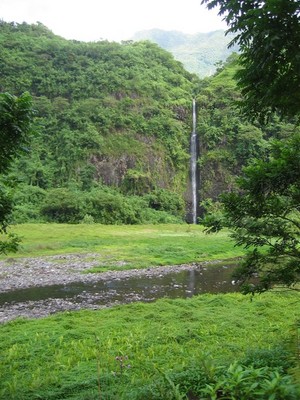
We turned off the main road onto a scary dirt road to get to the swimming hole. We didn’t actually go in for a swim. Aaron mentioned that the hole was pretty dry right now and pointed out where the water line normally goes to. He then explained to us that the main road was a relatively new road. Up until a couple years ago, the little scary dirt road was the only road. It paralleled the river and was usually muddy and often completely covered with water when the river was full. That is why the tour company had such robust 4 wheel drive vehicles with a snorkel. Aaron said that they would do the tour even when the water level was so high that the people in the back were getting their feet and legs wet. They’d stow all the gear on the roof of the vehicle to keep the stuff dry. Everyone would hold onto the roll bars for dear life and Aaron would reassure them all was fine while his heart was pounding.
We stopped by a lake that fed a second hydroelectric plant. We were surprised to see eels in the lake. We thought they were only sea animals, but apparently they are brackish animals and go back and forth between ocean and lake.

Here Aaron told us that in the old days there were several tribes that lived in this valley. The natives preferred the valley to the beach, as there was more protection from other tribes. It sounds like all the tribes were always at war with one another on all these islands. With the introduction of modern conveniences, like electricity, everyone moved out of the valley and down to the beach to be able to enjoy those comforts. We found it ironic that there is no electricity in the valley that they make electricity in.
Our last stop was a view of the top of the mountain. Aaron said that the mountain height is reduced by about 3 cm per year, sometimes more, every year. The mountain is definitely eroding away and will someday become an atoll like the Tuomotu Islands.
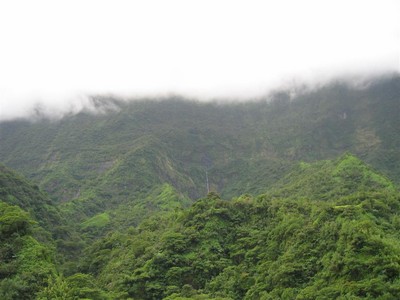
Once the tour was over, we wished we had signed up for the full day tour, where you go all the way to the top of the mountain and see an ancient native archeological site. We hadn’t realized how difficult it would be to go back and do that another time. Oh well.
We had another unique sunset, completely different from the night before. We just cannot get over the sunsets out here.
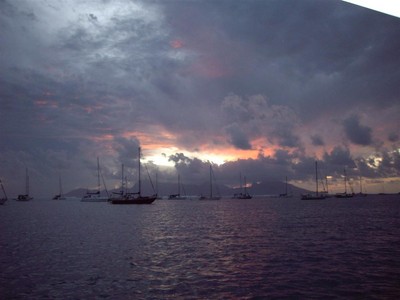


Hi there,
I was under the impression Shelley and Pete were meeting up with the two of you and have been following your blog to see how things were going with Shelley’s trip. I’m a coworker of hers at JetBlue. I am concerned since I see now mention of her on here and y’all just arrived in Tahiti on the 25th. Have you heard from her? Is she ok?
Thank you,
Vanessa
The blog posts are not quite in real time. This is due to a combination of slow and inconsistent Internet, and giving us some time to put the entries together. So the dates posted are not the dates written. It was getting confusing putting both dates, so we just left out the actual date.
Shelly is good. There will be several blog updates coming about Pete and Shelly’s visit! 🙂
We usually do not post comments, because of Internet bandwidth reasons, but we have a some of bandwidth right now. Although there is a big boat blocking our wireless at the moment.
Thank you for letting me know! I was relieved to hear she landed in Burbank today. heh
Yeah, I worry needlessly a lot. I am glad everything is good and that the posts timestamp isn’t dead on. phew!
Thanks,
Vanessa